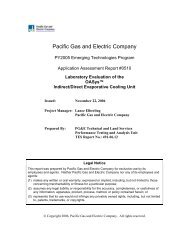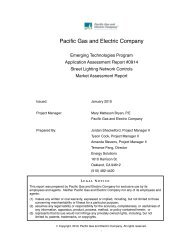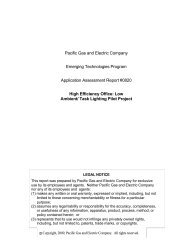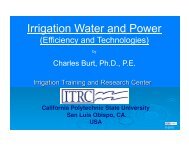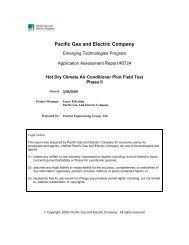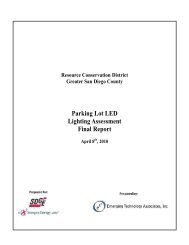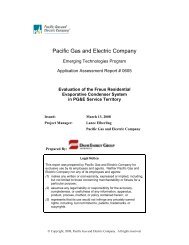PGE Wireless Pneumatic Thermostat ET Final Report.pdf
PGE Wireless Pneumatic Thermostat ET Final Report.pdf
PGE Wireless Pneumatic Thermostat ET Final Report.pdf
Create successful ePaper yourself
Turn your PDF publications into a flip-book with our unique Google optimized e-Paper software.
PG&E’s Emerging Technologies Program <strong>ET</strong>11<strong>PGE</strong>3171<br />
INCENTIVES<br />
Customized Retrofit Incentive: The savings amounts for the CRI program are shown in the<br />
table below. (Disclosure: kW Engineering performed the CRI savings calculations.) The<br />
savings were calculated using a temperature bin simulation. Because the outdoor air<br />
temperature sensor was installed prior to the retrofit, the DSP measure was not eligible for<br />
a CRI incentive. Thus, the only approved measure was a zone setpoint deadband. The<br />
incentive from the CRI program was $3,007. It should be noted that the calculation<br />
methodology for this CRI incentive was not an M&V approach. Rather, the program<br />
approves engineering calculations before the retrofit and modifies those calculations based<br />
on observations after the installation.<br />
Table 6: Pilot Site 1 - CRI Program Savings Amounts<br />
Emerging Technology Assistance Program (<strong>ET</strong>AP): The savings amounts from the <strong>ET</strong>AP<br />
program are shown in the table below. An engineering review was performed prior to the<br />
project start and was not revised upon completion. The incentive from the <strong>ET</strong>AP program<br />
was $8,564.<br />
Table 7: Pilot Site 1 - <strong>ET</strong>AP Program Savings Amounts<br />
COMMENTS AND OBSERVATIONS FROM SITE STAFF<br />
The building management is not looking to quantify the savings in any discrete way:<br />
“hard to see in bills”.<br />
The installation contractors performed a formal training session with building staff of<br />
approximately 2 hours.<br />
The site had difficulty supplying power to the wireless repeaters. The site had<br />
intended to hardwire the repeater power supply, but they could not run the wiring<br />
due to asbestos issues. They opted for a plug in power supply to available outlets.<br />
A site contact noted that the pneumatic tubing was difficult to install due to the<br />
copper-to-plastic fittings taking up too much room. Building maintenance had to go<br />
back to fix about 2 dozen kinked tubes.<br />
The WPT wall unit installations left open patchwork on walls that needed to be<br />
repainted.<br />
FUTURE POTENTIAL<br />
kW kWh Therms<br />
CRI Calculated Incentive (PA) 9.97 53,762 2,441<br />
CRI Verified Savings (IR) 5.74 11,110 1,433<br />
kW kWh Therms<br />
<strong>ET</strong>AP Program Savings Amounts 10 47,580 2,149<br />
Site staff commented that the initial application of controls using the WPT installation was<br />
conservative, but that their goal is to adjust the setpoints and integration at a later point to<br />
be more aggressive. However, the site contact also commented that constrained resources<br />
might make future modifications unlikely. The site is participating in ongoing<br />
30



